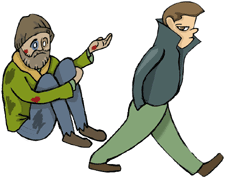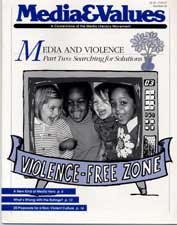No More Blood at Eleven: Alternatives to Crime Reporting
|
This article originally appeared in Issue# 63
|
I made a resolution years ago to stop watching cop shows right before I went to bed. The corpses and car chases gave me nightmares. More and more often, the broadcasts open with the "nightside" reporter standing in front of the blood-soaked pavement next to the coroner's van.
Now it's the real life corpses that are keeping me up nights. It didn't used to be this way. A couple of years ago, it was fashionable to lead with a fire – any fire. One news director confessed he'd open his nightly newscast with flames and firemen from a blaze anywhere in the nation. The pictures of an active catastrophe made "good television."
These days, fires are out. Today, if it bleeds it leads.
Ironically, crime stories usually provide a dearth of interesting images for a medium that relies so heavily on pictures. Washington Post TV columnist Jack Carmody says local coverage of crime stories' "make lousy TV." 'It's never very dramatic," he says, "the reporter relating the latest horror within the glare of police lights with yellow crime tape flapping in the wind."
Don't just show us the chalk drawings of the body in the street...give us something we can do besides tighten the iron bars on our windows.
Yet, Reed Manville, the general manager of NBC's affiliate in Los Angeles, defends his station's preoccupation with violence. He says viewers want to see crime stories– "It makes them feel better about their own situation," to know "that it's not their family."
I disagree. Crime stories do not make us feel better. They scare the dickens out of us. Sure, scary stuff has always been good copy from Edgar Allan Poe to Halloween, Part 25. In fact, newspapers owe their rise in popularity at the end of the last century to the orgy of crime crammed onto their front pages. Today we criticize such reporting as "yellow journalism." What will future generations call the kind of news we put on the air today?
But why look ahead to the distant future? What messages are we sending to the youngest generation of viewers watching today? Bad guys get their 15 minutes of fame just by "taking out" a cop, shooting up a rival gangbanger or targeting some pregnant woman in a carjacking. If you were a kid today, who would your heroes be?
There is a better way to cover crime stories. If violence is of such great interest, why not put it into  some kind of context? Don't just show us the chalk drawing of the body in the street. Give us some insight about why two street gangs are willing to go to war for the sake of a few blocks of turf. Show us how a typical police investigation works. Walk us through the criminal justice process. Bring us in on a crime victims' support group.
some kind of context? Don't just show us the chalk drawing of the body in the street. Give us some insight about why two street gangs are willing to go to war for the sake of a few blocks of turf. Show us how a typical police investigation works. Walk us through the criminal justice process. Bring us in on a crime victims' support group.
Or better yet, give us something we can do besides tighten the iron bars on our windows. Profile that under-funded group trying to keep kids out of gangs or the anti-truancy program that's been rounding up the ones playing hooky. Such programs are always starving for money– and volunteers. Give us a story about the correlation between illiteracy and a life of crime. Then show us a literacy program that works.
Television is a wonderful and powerful medium. It can tell a story with little else but pictures. But use those pictures to tell the rest of the story– don't just focus on the blood on the boulevard. Television news programs have a responsibility to inform the community without airing a montage of gore. I'm not advocating goody-two-shoes news here. But if you're going to make money from the tragedies in our communities, then take some responsibility for the life of our communities. Or else there might not be much of a community left when the TV lights are turned off.



